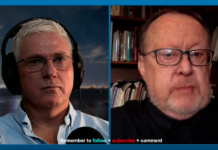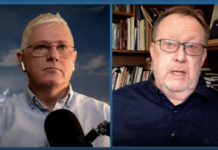Analysis by Keith Rankin.

In the present conflict that has huge potential to escalate into a global catastrophe, it is appropriate to impose the highest level of opprobrium on Russia’s present military agenda, and on Russia’s president, Vladimir Putin. However, that does not excuse us from the need to critique problematic behaviour by other ‘actors’, and to reflect on structural weaknesses in the geopolitical order as presented by ‘the west’.
The geopolitical order as presented by ‘the west’ has two overlapping components: the ‘territorial fundamentalism’ and the ‘rules-based-international-order’. The rules-based-order is problematic on the basis of who sets the rules, and in which zeitgeist they were they set. When the rules are either too rigid or plain wrong, how do they get corrected? And territorial fundamentalism is based on a historically peculiar early twentieth century American-centred worldview; a view that makes the democratic process to change countries’ boundaries about as difficult as making changes to the United States’ electoral-college-based electoral system. (We may note that, especially but not only in the United States, the process of changing state and county boundaries is almost equally challenging.)
(On 21 August 2021 I wrote Territorial Fundamentalism in our Post-Globalisation Era. And – on 14 February 2022 – Nations, Territories, and Conflict.)
Dissolutions and Reunifications
Under the postcolonial ‘territorial system’, new nations form mainly as a result of dissolutions and reunifications, mainly dissolutions. The dissolutions with which we are most familiar are those of the former Soviet Union (USSR) and the former Yugoslavia.
On the reunification side, one of the best post-1950 examples is that of Germany. Last week I watched the Netflix docuseries ‘A Perfect Crime’, which is about the early 1990s’ reunification of Germany, which involved the merging of the smaller and poorer East Germany with a capitalist West Germany that was already economically dominant in Europe. [The ‘perfect crime’ itself was the murder of Detlev Karsten Rohwedder, the managerial (but himself politically centrist) appointee to oversee the integration of East German (GDR) assets into what was essentially the West German system.] Indeed, the reunification was, for all practical purposes, a takeover of the east by the west; and, as such, was opposed by many in East Germany, and not only diehard ‘communists’. While the murder remains unsolved – and both Red Army Faction (leftist radicals) and former Stasi (GDR secret police) conspirators were investigated as likely culprits – the program finished with the sense that the main beneficiaries of Rohwedder’s death were the rightist-radicals with a privatisation agenda that was part of the zeitgeist around 1990 (vis the privatisation agendas in New Zealand and Russia). Rohwedder’s successor was a more radical privatiser than Rohwedder ever was.
In an important sense, what Russia’s Putin is trying to do is similar; to reunify Russia, with the larger partner effectively swallowing the smaller. And with the smaller ‘partner’ (ie Ukraine in this case) having ‘many elements’ who are unconstructive (from the larger partner’s viewpoint), needing to be bullied into submitting to the reunification project. From Putin’s viewpoint, the main difference is that the ‘radical rightists’ are within the smaller (bullied) rather than the larger (bully) partner.
The central issue, which makes such ‘reunifications’ contemplatable despite the territorial system, is that one party is significantly larger than the other. Asymmetry, in other words, has been the key prerequisite for rare recent reunifications. In Vietnam after 1975, that asymmetry arose after South Vietnam was a defeated puppet state. Other post-1950 reunifications I can think of are post-colonial Yemen, which has now resplit; and the partial reunification of Israel and Palestine; both continue to be highly fraught political situations. Another is the evolving – and asymmetric, and fraught – reunification of China and Hong Kong. (There are examples of post-war unification – not reunification – which are less fraught: Tanzania and Malaysia come to mind, both practical realities of post-colonial circumstance.)
Asymmetry in History
One of the more obvious asymmetries has been that of the United States with respect to ‘Pan-America’. This asymmetry includes, in the nineteenth century, a failed war to incorporate what is now Canada, and successful action to incorporate Texas and annexe large parts of Mexico. There was also the bloody US Civil War of reunification, following the secession of the plantation south from the industrial north. In a wider twentieth century sense, the United States adopted an informal hegemony over the Latin American and Caribbean states; a hegemony that has weakened in recent decades, due to the stronger assertion of national sovereignty in the Americas’ region (perhaps due to weakening asymmetry in the Americas).
Another is India, which – after decolonisation – split into two and then three identity-based sovereign states. (If India, Pakistan, and Bangladesh had remained a single country, it would be easily the world’s most populous.) The split in 1947 has aggravated rather than resolved the differences; and modern India has a clear asymmetry in the region, enabling it to prevail through the ‘might over right’ asymmetry that size grants to India. Another is China, which will never let any of its present territory go (such as East Turkestan or Tibet), while using bullying tactics to keep alive its outstanding unification claims.
Germany was unified in the early 1870s, when German nationalist proclivities in the more economically backward east of the German-speaking territories pushed to incorporate the more traditionally autonomous western principalities. (Switzerland, the most traditionally autonomous of these, staunchly maintained its ‘mountain’ independence, having a greater sense of commonality with similarly predisposed French and Italian speaking ‘cantons’.) And Austria, through its own heterogeneous empire and its alliance with Hungary, also was able to resist incorporation into the powerful new Prussian state. In the twenty-first century, Germany is no longer asymmetric. If today’s Federal Republic of Germany was to split into its constituent provinces (Länder), they would probably be able to operate as independent nations without inter-territorial conflict.
Ethiopia provides an interesting case; a Soviet Union aligned state in the 1980s. It even became the ‘communist’ People’s Democratic Republic of Ethiopia in 1987. In and before the 1980s, Eritrea fought an eventually successful war of independence and liberation against the increasingly repressive Ethiopian state. The irony today is that it is now Ethiopia that sees itself as a progressive member of the world’s community of nations, and Eritrea has joined the ranks of the weird. When adjusted for its population, Eritrea has posibly been the largest source country for refugees in the last ten years, and was the one African country to vote with Russia in the recent General Assembly vote to condemn Russia’s invasion of Ukraine.
Another African country to note is Sudan, which fought a long and futile ‘civil war’ which ended in the internationally recognised secession of South Sudan. Sadly, the war exhausted the new state, which is now one of the poorest and least secure nations of the world.
Other Federations
If we imagine the split-up of most other Federations, such as Australia, Canada, Brazil and Mexico, then it seems unlikely that an asymmetric Russia-Ukraine situation could materialise from them. Although Canada might be interesting, given its uneasy and ongoing Anglo-French history.
In Australia, the covid pandemic has surprised us in New Zealand just to what extent the different states could maintain territorial and administrative independence from each other. In any new unfederated future, presumably Canberra would be absorbed by New South Wales (NSW); and Victoria and NSW would maintain a balance of regional power that would facilitate the security of the smaller states.
It might not have been so well-balanced, though, if history had taken a different course. Victoria broke away from NSW in 1851. Queensland later broke away from NSW in 1859. In the twentieth-century world of territorial fundamentalism, it would be hard for such secessions to have taken place. The counterfactual Australia today would be made up of four states: New South Wales, Western Australia (probably as New Holland), South Australia (including its ‘northern territory’), and Tasmania. In an imaginary break-up of such an Australia, NSW would have dominated much as Russia dominated when the Union of the Soviet Socialist Republics (USSR) broke up. We could imagine such an NSW coveting the prosperous wheatlands of South Australia.
A breakup of Canada could be interesting, with Ontario dominant with respect to its western neighbours, and Quebec (formerly New France) similarly so with respect to its small eastern neighbours.
It’s worth noting that New Zealand – opposite to Australia – effectively defederalised (in 1876); not by breaking up, but by abolishing the provincial governments; an exercise in centralisation, and probably not the last. (We still remember those colonial times through our respective provincial anniversary holidays.) Had New Zealand not defederalised, and it were now set to breakup, there would be a major asymmetry. Auckland would outpopulate the other eight provinces combined, giving it the opportunity to form hegemonic relationships with, in particular, Taranaki and Hawkes Bay.
Netherlands is an interesting case. Europe’s first republic was comprehensively dominated by Holland, to the extent that the names Netherlands and Holland were almost interchangeable to many outsiders. This situation has been rationalised however – not unlike the New Zealand situation. Netherlands can no longer be regarded as a federation, and Holland has been split into two administrative divisions. Netherlands still has its imperial realm in the Caribbean, much as New Zealand has its realm in the South Pacific.
Kurdistan
Kurdistan is a natural nation that has no hope of being able to achieve that aspiration in the post-twentieth century world of sacrosanct territorial borders and inter-territorial rules. Its formation would require a degree of deunification in four countries and then a unification of those four parts. Too complex for the international community of nations to envisage, especially given the precedents it might set to separatist forces elsewhere.
Russia and England
Russia has always been a source of asymmetric instability in the far east of Europe and the north of Asia; certainly, since the sixteenth-century times of Ivan the Terrible, and Tsar Peter the Great in the seventeenth century. Most important, in the Tsarist period, was Russia’s far-eastwards expansion in the nineteenth century, an expansion that matched the simultaneous westward expansion of Europeans into the ‘wild west’ of United States. The result is that in, whatever its form might have been at the time, Russia was always substantially bigger – in land and population – than any of its varying neighbours. It is hard to imagine how that asymmetry may end, although the Netherlands’ and Australian examples do suggest that it is possible; just difficult.
An interesting comparator to Russia is that of England. Indeed, both the concepts of Russia and England were cemented by Scandinavian settlers and kings, in the years between 960 and 1020. And, just as this history of Russia is not well known outside of Russia, the English story is even less well known, even by the English themselves.
Here’s a potted account. The Anglo-Saxon ‘settlement’ of Britain dates to around the year 500, and eventually dominated the island of Britain. Britain divided into six loosely-defined polities (plus a few smaller places such as Kent and Cornwall): Scotland, Wales, Mercia, Wessex (West Saxony), East Anglia, and Northumbria. The last four of these were Anglo-Saxon (ie English). So, already, the English were dominant in Britain.
Around 920, Aethelstan – grandson of King Alfred the Great, of Wessex – became the first ‘King of the English’. But there was no England as such, and much of the English lands were dominated by Danish settler families, under the Danelaw. The Danelaw was particularly centred around the area known today as the East Midlands, but extended through into what is now Lancashire.
By and large, in the tenth century, the Anglo-Saxons and the Danes lived in these English lands in relative harmony; though Danes from Denmark continued to raid and draw tribute (Danegeld) from the settled population. In the year 1002, King Aethelred, ordered an act of ethnic cleansing which became known as the St Brice’s Day massacre. While little is known about the true extent of the massacre, it is known for sure that it was particularly bad in the town of Oxford.
This event aroused the King of Denmark – Sweyn Forkbeard (son of Harald Bluetooth, after whom the comms technology is named) – to act in support of the Danes in Britain. By 1013, Sweyn had conquered the English lands, and was recognised as King of the English after King Aethelred fled to Normandy (where Aethelred’s wife Emma was from). Soon after ,Sweyn died suddenly; most likely from natural causes. He was in his fifties, not a young man in those days. The result was an all-out struggle for what was becoming ‘England’ Aethelred returned, but died. So the war was essentially embarked upon by the two sons, Edmund (son of Aethelred) and Cnut (son of Sweyn, later sometimes known as Cnut the Great, the North Sea Emperor). Cnut prevailed when Edmund died, though the military outcome had been a draw. Cnut went on to marry Edmund’s ‘stepmother’ Emma, as his second wife. (These event of the early 1000s are now covered, as historical drama, in the new Netflix series Vikings: Valhalla.)
In a book written for children – Who Made England? – Chip Colquhoun answers ‘Knut’, who became a popular monarch. (Colquhoun uses the Scandinavian spelling ‘Knut’ rather than the more commonly accepted English spelling.) It was under Cnut that England became a single administrative entity, and not just a collection of English kingdoms or earldoms. The link to Normandy through Queen Emma eventually led to the subsequent Norman Conquest of 1066. Had Sweyn lived, the millennial history of England could have been very different; probably even more English, and without the Norman interlopers.
Either way, England had been made, and could not be easily unmade. England’s dominance of the British Isles led to the subjection of Ireland in the twelfth century; Wales and Scotland in the thirteenth. Scotland – still a kingdom, albeit a puppet kingdom – fought back in the early fourteenth century, creating a new line of kings. The two kingdoms were then reunited in the seventeenth century, and Scotland was annexed by England in the eighteenth. In the nineteenth century the United Kingdom of England, Scotland and Ireland was formed. In the twentieth century that was reduced to United Kingdom of England, Scotland and Northern Ireland; this followed a centuries-long secessionary movement for Ireland’s political independence.
Although Scotland retained (and extended in the 1990s) a degree of autonomy from England, the relationships between the component nations of the British Isles remains fraught, and the major single reason is the asymmetry in size between England and its neighbours. England has three-quarters of the population of the British Isles.
One long-run solution here would be for England to revert to its four ‘earldoms’: Mercia, Wessex, East Anglia, and Northumbria; maybe not using the exact same boundaries that applied in the year 1000. Under that scenario, the United Kingdom would become a federation of seven states, including Scotland, Wales and Northern Ireland. And with an option to Ireland to rejoin (in case the European Union eventually ‘turns to custard’), much as the door remains open in Canberra for New Zealand to join the Commonwealth of Australia.
One particular anomaly in the United Kingdom is that three of its four members have their own national assemblies (devolved parliaments), but that England does not. Thus, the Parliament of the United Kingdom simultaneously serves as the Parliament of England. The problem is that, if there was a separate English Parliament, there would not seem to be much for the (federal) parliament at Westminster to do. And that remains an issue for federal parliaments in general. Does Australia really need Canberra? Does Canada need Ottawa? Does Brazil need Brasilia?
Back to Russia
The Soviet Union collapsed after the reconstitution in 1990 of the Supreme Soviet of the Russian Soviet Federative Socialist Republic, with Boris Yeltsin as its first reconstituted chairman. Mikhail Gorbachev was Chairman of the Soviet Union. In United Kingdom terms, this would have made him Prime Minister of England, coming up against the Prime Minister of the United Kingdom. If, in the United Kingdom, both positions existed, and both were held by headstrong political rivals, then the Prime Minister of the United Kingdom – and hence the United Kingdom itself – would have been undermined. That is simply not a stable configuration of political power. I think we can say that Boris Yeltsin gaslighted Mikhail Gorbachev.
The solution I have suggested for the United Kingdom would be for England to reverse its unification under Cnut, and to split into four state polities, based around the historical states of Mercia, Wessex, East Anglia, and Northumbria. Then these four polities could become equals to Scotland and Wales within the United Kingdom.
Likewise, the region of Eurasia, long-dominated by Russia, can probably never be stable in a liberal way unless Russia itself splits up. Then a stable eastern union could form around some form of liberal principles; not necessarily the same form that underpins the European Union, but a comparable set of principles.
It would be unrealistic to see something like this happening this decade, maybe even this century. Further, the Russian Federal Republic is more complicated than England. It is made up of a mix of 26 sub-republics (eg Chechnya) and autonomous districts, 55 oblasts (like British counties or Japanese prefectures), and three ‘federal cities’ (including Sevastopol in Crimea). (We note that Chechnya was dealt to rather severely, when it attempted to secede from Russia.)
So, if Russia was to split, then it would split into 27 nation-states, with one republic – ‘Russia’ (made up of the 55 oblasts) – still completely dominant!
There’s no obvious route towards a liberal decentralisation of Russia based on existing sub-national borders. Rather, a pragmatic decentralisation of Russia would require recourse to a set of (at least two) more distantly historical nation states; again, comparable with the states of Mercia, Wessex et.al. (If just two sub-Russias – like North Holland and South Holland – they would need to be of similar size, creating a balance of regional power.)
Conclusion
No matter how difficult to achieve in practice, a recourse to history (and to a vision of balanced politics in action) can allow people to imagine a stable world order, with a mix of large and small nation states, and with allowance for the use of democratic processes to adjust international borders when the benefits to the local people of doing so would outweigh the costs.
*******
Keith Rankin (keith at rankin dot nz), trained as an economic historian, is a retired lecturer in Economics and Statistics. He lives in Auckland, New Zealand.








